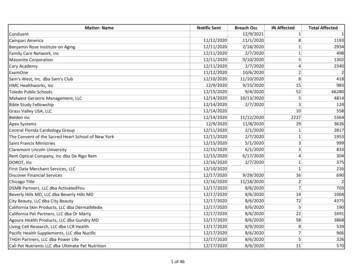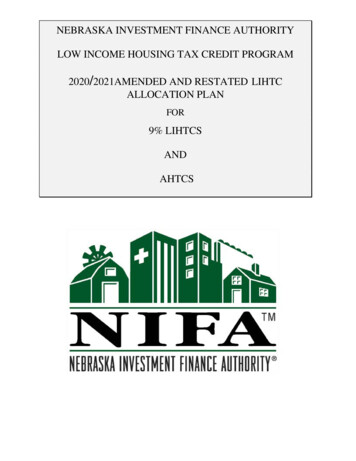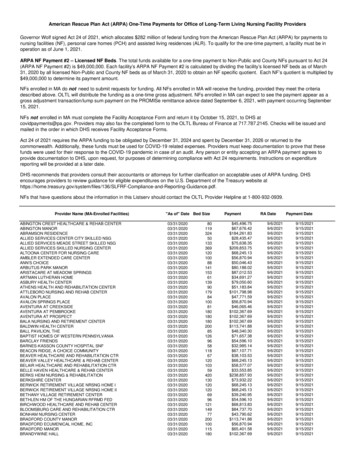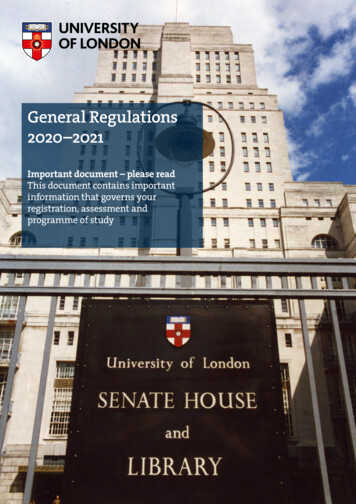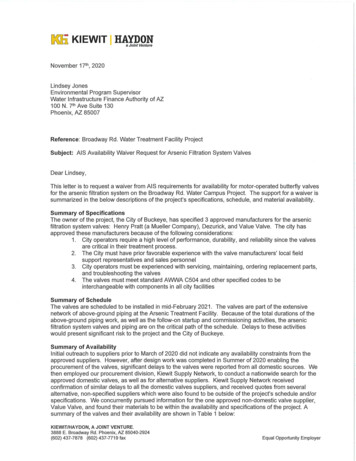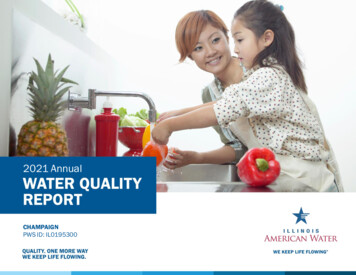
Transcription
2020 Annual2021SYSTEM NAMECHAMPAIGNPWS ID: XXXXXXXXXXPWS ID: IL0195300
What is a Consumer Confidence Report2Once again, we proudly present our Annual Water Quality Report, also referred to as a ConsumerConfidence Report (CCR). CCRs let consumers know what contaminants, if any, were detected intheir drinking water as well as related potential health effects. CCRs also include details aboutwhere your water comes from and how it is treated. Additionally, they educate customers on what ittakes to deliver safe drinking water and highlight the need to protect drinking water sources.A message from our President3Mark of Excellence4About Your Drinking Water Supply5What are the Sources of Contaminants?6Illinois American Water is committed to delivering high quality drinking water service. To that end,we remain vigilant in meeting the challenges of source water protection, water conservation,environmental compliance, sustainability and community education while continuing to serve theneeds of all our water users.Protecting Your Drinking Water Supply7About Lead8Important Information About Your Water9-10Water Quality Results11Definitions of Terms Used in Document12Water Quality Results: Detailed Charts13-15About Us16Contact Us172
A message from Illinois American Water’s PresidentDear Illinois American Water Customer,Illinois American Water is proud of the role we play in your community and daily life. Thewater service we deliver is an important tool for local firefighters, manufacturers and smallbusiness owners. Safe, reliable drinking water is also a key ingredient for your morningcoffee, food preparation, household chores and more. This is why delivering high-qualitywater service to keep life flowing is our top priority.Our 2021 Consumer Confidence Report is a testament to our continued commitment to ourcustomers. We hope our dedication to you and our passion for water shines through in thisreport detailing the source and quality of your drinking water in 2021.JUSTIN LADNERPresident, IllinoisAmerican Water.This report containsimportant informationabout your drinkingwater. Translate it orspeak with someonewho understands it at(800) 422-2782,Monday-Friday,7 a.m. to 7 p.m.QUALITY: We monitor and test your water at multiple points throughout our process ofdrawing it from its source, treating it to meet drinking water standards, and distributing itthrough our pipeline systems. In fact, we test for about 100 regulated contaminants asrequired by state and federal drinking water standards. We also remain committed toprotecting our sources of drinking water. We utilize advanced technology and detectionmethods that are paving the way for source water protection across the country, and weimplement green technology whenever possible to protect our precious resources.SERVICE: In 2021, we invested approximately 196 million to upgrade our water andwastewater treatment and pipeline systems in the communities we serve. These investmentsallowed us to improve water quality, water pressure, system security and service reliability forour customers.VALUE: While costs to provide water service continue to increase across the country, ourteam has worked hard to improve efficiencies. Illinois American Water’s operating andmaintenance costs per customer have remained unchanged since 2012, supportingexceptional value for such an essential service.We are proud to be your local water service provider. We will continue to work to keep yourlife flowing – today, tomorrow and for future generations.Justin LadnerIllinois American Water3
Just as Illinois American Water invests in research and testing, wealso understand the importance of investing in the infrastructurethat provides high-quality water service to you. Last year alone, weinvested approximately 196 million to improve our water andwastewater treatment and pipeline systems.4
WHERE YOUR WATER COMES FROMThe source of supply for the Champaign District isgroundwater. Currently 21 wells deliver water fortreatment to two lime softening plants: the MattisAve Plant, located in Champaign, and the BradleyAve Plant, located West of Champaign. The wellsareprimarily located in the Mahomet Sands Aquiferand supplies both plants. The wells range from208 to 366 feet in depth and are protected fromsurface contamination by geologic barriers in theaquifers. The Illinois Environmental ProtectionAgency(IEPA) has determined that Illinois AmericanWater - Champaign wells are not susceptible toIOC, VOC, or SOC contamination. Thisdetermination is based on several criteria includingmonitoring conducted at the wells; monitoringconducted at the entry point to the distributionsystem; and the available hydrogeological data forthe wells.The Illinois Environmental Protection Agency (IEPA)has completed a source water assessment for theChampaign system anda copy is available uponrequest by calling Markesha Davis Supervisor ofWater Quality and Environmental Compliance at217-377-4764. To view a summary version of thecompleted Source Water Assessments, includingImportance of Source Water; Susceptibility toContamination determination; and documentation/ recommendation of Source Water ProtectionEfforts, you may access the IEPA website eet.aspxwww.epa.gov/watersenseDID YOU KNOW?that easy-to-fix waterleaks account for nearly1 trillion gallons of waterwasted each year in U.S.homes? In fact, theaverage household leaksnearly 10,000 gallons ofwater per year, or theamount of water it takesto wash 300 loads oflaundry.Many common householdleaks are quick to findand easy to fix. Worntoilet flappers, drippingfaucets, and leakingshowerheads all areeasily correctable andcan save on your utilitybill and water in yourcommunity.Remember to look for theWaterSense label whenpurchasing plumbingproducts. WaterSenselabeled products areindependently certified touse at least 20 percentless water.5
6
WHAT ARE WE DOING?Our priority is to provide reliable, quality drinkingwater service for customers. The source of supply isan important part of that mission. We work tounderstand and reduce potential risks to yourdrinking water supply.Here are a few of the efforts underway to protectour shared water resources:Report any spills, illegal dumping or suspiciousactivity to Illinois Environmental ProtectionAgency: www.epa.illinois.gov or (217) 782-3397.FOR MORE INFORMATIONTo learn more about your water supply and localactivities, visit us online at illinoisamwater.com.If you would like to provide input on source waterprotection and related activities, please call 800422-2782 and ask to be put in contact with thewater quality source water protection lead.Community Involvement: We have aproactive public outreach program to helpspread the word and get people involved.This includes school education, contests, andother community activities.Environmental Grant Program: Each year,we fund projects that improve waterresources in our local communities.Pharmaceutical Collection: We sponsordrop box locations across theCommonwealth for residents to safelydispose of unwanted drugs for free. Thishelps keep pharmaceutical products fromentering water supplies.Protect Our Watersheds Art Contest:Open to third, fourth, and fifth graders, thecontest encourages students to use theirartistic skills to express the importance ofwater service.We also take a green approach to our operations.We recycle to reduce waste, use solar to generatepower, partner with farmers to apply residualsand biosolids, and more.7
If present, elevated levels of lead cancause serious health problems, especiallyfor pregnant women and young children.Lead in drinking water is primarily frommaterials and components associated withservice lines and home plumbing.American Water is responsible forproviding high quality drinking water, butcannot control the variety of materialsused in plumbing components. When yourwater has been sitting for several hours,you can minimize the potential for leadexposure by flushing your tap for 30seconds to 2 minutes before using waterfor drinking or cooking. If you areconcerned about lead in your water, youmay wish to have your water tested.Information on lead in drinking water,testing methods, and steps you can take tominimize exposure is available from theSafe Drinking Water Hotline or athttp://www.epa.gov/safewater/leadCHECK YOUR PLUMBING AND SERVICE LINEIf you live in an older home, consider having a licensed plumber check your plumbing forlead. If your service line is made of lead, and you’re planning to replace it, be sure tocontact us at 1-800-422-2782.8
IMPORTANT HEALTH INFORMATIONDrinking water, including bottled water, may reasonably beexpected to contain at least small amounts of somecontaminants. The presence of contaminants does notnecessarily indicate that water poses a health risk. Moreinformation about contaminants and potential health effectscan be obtained by calling the EPA’s Safe Drinking WaterHotline (1-800-426-4791).Some people may be more vulnerable to contaminants indrinking water than the general population. Immunocompromised persons such as persons with cancer undergoingchemotherapy, persons who have undergone organtransplants, people with HIV/AIDS or other immune systemdisorders, some elderly, and infants can be particularly at riskfrom infections. These people should seek advice aboutdrinking water from their health care providers. EPA/CDCguidelines on appropriate means to lessen the risk of infectionby Cryptosporidium and other microbial contaminants areavailable from the Safe Drinking Water Hotline (1-800-4264791).If you have any questions, please call Illinois American Water’sCustomer Service Center at (800) 422-2782.9
UNREGULATED CONTAMINANTMONITORING RULE (UCMR)The EPA created the UnregulatedContaminants Monitoring Rule (UCMR) to assistthem in determining the occurrence ofunregulated contaminants in drinking water andwhether new regulations are warranted. The firstUnregulated Contaminants Monitoring Rule(UCMR1) testing was completed in 2003 for a listof contaminants specified by the EPA.Unregulated contaminants are those for whichthe EPA has not established drinking waterstandards. UCMR2 testing was conductedbetween November 2008 and August 2009, andUCMR3 assessment monitoring was conductedbetween January 2013 and December 2016. Thefourth list of contaminants to monitor as part ofthe UCMR was published by the EPA in December2016. UCMR4 testing began in 2018 and wascompleted in 2020. The results from the UCMRmonitoring are reported directly to the EPA. Theresults of this monitoring are incorporated in thedata tables in this report as appropriate. For moreinformation, contact our Customer Service Centerat 1-800-422-2782.PFAS MonitoringPFAS refers to per- and polyfluoroalkyl substances, a class ofsynthetic chemicals, manufactured for industrial applications andcommercial household products such as: non-stickcookware; waterproof and stain resistant fabrics andcarpets; firefighting foam and cleaning products. The properties thatmake these chemicals useful in so many of our every-day productsalso resist breaking down and therefore persist in theenvironment. Exposure may be from food, food packaging, consumerproducts, house dust, indoor and outdoor air, drinking water and atworkplaces where PFAS are made or used.The science and regulation of PFAS and other contaminants isalways evolving, and Illinois American Water strives to be a leaderin research and development. PFAS contamination is one of themost rapidly changing areas in the drinking water field. We haveinvested in our own independent research, as well as engaging withother experts in the field to understand PFAS occurrence in theenvironment. We are also actively assessing treatment technologiesthat can effectively remove PFAS from drinking water, because webelieve that investment in research is critically importantto addressing this issue.Illinois American Water is currently collecting samples to betterunderstand the occurrence of PFAS levels in drinking water and theirsources. This testing allows us to understand how our watercompares against the non-enforceable Health Advisory Level setby USEPA of 70 nanograms per liter or parts per trillionfor a combination of two PFAS compounds, PFOA andPFOS. Testing also allows Illinois American Water to be betterprepared if the USEPA or state environmental regulator develop adrinking water standard for those PFAS for whichwe have USEPA approved testing methods.IL EPA established Health Advisory Levels for several PFAS analytesin 2021. For more information about PFAS health erquality/pfas/Pages/pfas-healthadvisory.aspx10
WATER QUALITY STATEMENTWe are pleased to report that during calendaryear 2021, the results of testing of yourdrinking water complied with all state andfederal drinking water requirements.For your information, we have compiled a list inthe table below showing the testing of yourdrinking water during 2021. The IllinoisEnvironmental Protection Agency allows us tomonitor for some contaminants less than onceper year because the concentration of thecontaminants does not change frequently.Some of our data, though representative, aremore than one year old.11
12
Illinois American Water conducts extensive monitoring to determine if your water meets all water quality standards. The detections of our monitoring are reported in thefollowing tables. While most monitoring was conducted in 2021, certain substances are monitored less than once per year because the levels do not change frequently.For help with interpreting the tables below, see previous page “Definition of Terms”.HOW TO READ THIS TABLE (FROM LEFT TO RIGHT) Starting with Substance (with units), read across. Year Sampled is usually in 2021, but may be a prior year. A Yes under Compliance Achieved means the amount of the substance met government requirements. MCLG/MRDLG is the goal level for that substance (this may be lower than what is allowed). MCL/MRDL/TT/Action Level shows the highest level of substance (contaminant) allowed. Highest, Lowest or Average Compliance Result represents the measured amount detected. Range tells the highest and lowest amounts measured. Typical Source tells where the substance usually originates.Some unregulated substances are measured, but maximum contaminant levels have not been established by the government. These contaminants are shown for yourinformation.NOTE: Regulated contaminants not listed in this table were not found in the treated water supply.LEAD AND COPPER MONITORING PROGRAM - Collected at customers’ taps.Substance(with units)Year SampledComplianceAchievedMCLGAction Level(AL)90th PercentileHomes AboveAction LevelTypical Source2021Yes01570Corrosion of household plumbing systems; Erosion ofnatural deposits.2021Yes1.31.30Erosion of natural deposits; Leaching from woodpreservatives; Corrosion of household plumbing systems.Lead (ppb)Copper (ppm)0.273TOTAL COLIFORM RULE - At least 120 samples collected each month in the distribution systemSubstanceYear SampledComplianceAchievedMCLGMCLHighest PercentageTypical SourceTotal Coliform2021Yes05% of monthlysamples are positive0.8%Naturally present in the environment.NOTE: Coliforms are bacteria that are naturally present in the environment and are used as an indicator of the general bacter iological quality of the water. We are reporting the highest percentageof positive samples.13
DISINFECTION BYPRODUCTS - Collected in the Distribution SystemSubstance(with ompliance ResultRangeDetectedTypical SourceHaloacetic Acids(HAAs) (ppb)2021YesNA603014 to 32.1By-product of drinking water disinfection.TotalTrihalomethanes(TTHMs) (ppb)2021YesNA807841 to 90.3By-product of drinking water disinfection.NOTE: Compliance is based on the running annual average at each location. The Highest Compliance Result reflects the highest average at any location and the Range Detected reflects allsamples from this year used to calculate the running annual average.DISINFECTANTS - Collected in the Distribution SystemSubstance(with ompliance ResultRangeDetectedTypical SourceChlorine (ppm)2021YesMRDLG 4MRDL 42.21.9 to 3Water additive used to control microbes.REGULATED SUBSTANCES - Collected at the Treatment PlantSubstance(with ompliance ResultRange DetectedTypical SourceArsenic (ppb)2021Yes01010 to 1Erosion of natural deposits; Runoff from orchards,Runoff from glass and electronics production wastes.Fluoride (ppm)2021Yes44.00.60.57 to 0.6Erosion of natural deposits; Water additive whichpromotes strong teeth; Discharge from fertilizer andaluminum factories.CombinedRadium226/228 (pCi/L)2018Yes051.5121.512 to 1.512Erosion of natural deposits.Gross alphaexcluding radonand uranium(pCi/L)2018Yes0151.241.24 to 1.24Erosion of natural deposits.
OTHER SUBSTANCES OF INTEREST - Collected at the Treatment PlantSubstance(with units)YearSampledComplianceAchievedMCLGMCLHighest ResultRange DetectedTypical SourceSodium (ppm)2021YesNANA45.140.1 to 45.1Erosion from naturally occurring deposits. Used in watersoftener regeneration.For healthy individuals, the sodium intake from water is not important because a much greater intake of sodium takes place fr om salt in the diet. However, sodium levels above therecommended upper limit may be of concern to individuals on a sodium restricted diet.UNREGULATED CONTAMINANT MONITORING RULEUnregulated contaminants are those for which the EPA has not established drinking water standards. The purpose of unregulated contaminant monitoring is to assist theEPA in determining the occurrence of unregulated contaminants in drinking water and whether future regulation is necessary. Every five years, the EPA issues a new list ofno more than 30 unregulated contaminants to be monitored.ADDITIONAL WATER QUALITY PARAMETERS OF INTERESTParameterUnitsYearAverage ResultRange DetectedTypical SourceTotal Haloacetic Acidsppb20192417 to 30By-product of drinking water disinfectionTotal Haloacetic Acids - Brppb20195.43.8 to 7.2By-product of drinking water disinfectionTotal Haloacetic Acids-UCMR4ppb20192821 to 37By-product of drinking water disinfectionManganese*ppb201940 to 19Naturally-occurring elemental metal; largely used in aluminum alloy production.Essential dietary element.* Manganese has a Secondary MCL of 150 ppb.15
16
WATER INFORMATION SOURCESIllinois American Waterwww.illinoisamwater.comC enters for Disease Control and Preventionwww.cdc.govUnited States Environmental Protection g-waterAmerican Water Works Associationwww.drinktap.orgIllinois Environmental Protection Agency (IEPA)www.epa.illinois.govSafe Drinking Water Hotline: sAccess to U.S. environmental datahttps://www3.epa.gov/enviroSurf Your WatershedLocate your watershed and a host of cfm17
CHAMPAIGN PWS ID: IL0195300 2021 Annual. Once again, we proudly present our Annual Water Quality Report, also referred to as a Consumer Confidence Report (CCR). CCRs let consumers know what contaminants, if any, were detected in their drinking water as well as related potential health effects. CCRs also include details about



